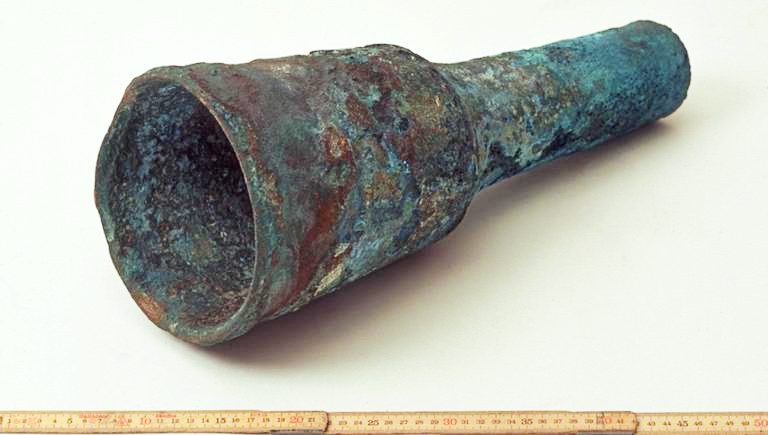A funnel-shaped cannon found by a recreational scuba diver off Sweden’s west coast could be Europe’s oldest shipboard gun, according to an inter-disciplinary team of researchers.
The diver made the discovery at a depth of 20m twenty-two years ago, but it is only now that the international team led by maritime archaeologist Staffan von Arbin of the University of Gothenburg have been able to announce that the gun is more than 600 years old – changing previous understanding of onboard weaponry.
Found off Marstrand, the small, muzzle-loading cast copper-alloy cannon is believed to have been a working ship’s cannon rather than one being carried as cargo. Traces of a charge remained in its powder chamber when it was found, indicating that it was loaded and ready to fire when the ship was presumably wrecked.
Funnel-shaped cannon are usually attributed to the 15th-16th centuries, so the researchers were surprised to find such an early example of the style.
At the same time the powder residues showed that cartouches – textile packaging for the charge – must have come into use far earlier than previously realised. UK mediaeval gunpowder weaponry specialist Kay Douglas Smith was involved in this aspect of the study.
“Thanks to the preserved remains of the charge, it has been possible to use radiocarbon dating to establish the age of the find,” says von Arbin. “The study’s findings show that the Marstrand cannon is probably from the 14th century, making it one of the oldest artillery pieces ever found in Europe.”
Chemical analysis
The gun was subjected to 3D scanning as well as chemical analysis, which revealed that the copper alloy employed in its manufacture contained about 14% lead and only small amounts of tin. This combination was described as “far from optimal” for casting cannon, because it was likely to crack if fired intensively for long periods.
“Clearly, the person who cast the cannon did not have the necessary knowledge and understanding of the properties of various copper alloys,” says von Arbin. “This shows that the noble art of cannon casting had not yet been fully mastered at that time, and that production was largely based on trial and error.”
The copper ore was mined in what is today Slovakia (then part of Hungary), while the lead was thought to have come either from England or what is now the border between Poland and the Czech Republic.
In the 14th century the port of Marstrand was an important hub for commercial shipping between western Europe and the Baltic area, but the region was also frequently caught up in war and piracy, so merchant vessels as well as warships were increasingly likely to be armed.
“Now, of course, we also want to try to locate and document the ship that the cannon belonged to,” says von Arbin. “Although it is probably severely degraded and broken up, it should be possible to find scattered remains of the wreck if we conduct a thorough inventory of the site and its surroundings.”
The cannon is displayed at the Bohusläns museum in Uddevalla, which collaborated on the open-access interdisciplinary study, which is published in the journal The Mariner’s Mirror.
London diver finds another Southend wreck

Steven Ellis, leader of the Southend dive-team that has spent recent years excavating the 17th-century historic shipwreck the London in the Thames estuary, has come across a previously unknown timber wreck, complete with spent bullet casings.
Ellis told the BBC that he had been surprised to come across the uncharted remains during a dive off Southend Pier last week when the water was unusually clear. He said that the wreck was “definitely worth further investigating”, and hoped to map the site before carrying out an archival trawl.
Also on Divernet: Divers report on rare cog wreck find, Norwegian wood: lake shipwreck intact after centuries, Cannon ‘twinkled like gold’ on lost wreck, Plymouth gun could be 400 years old

